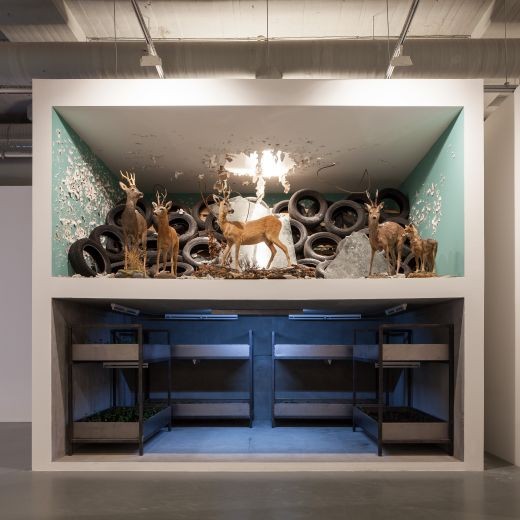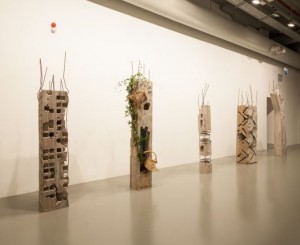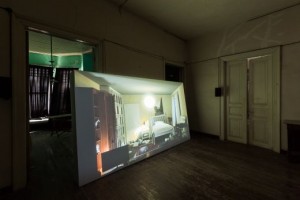A JOURNEY BETWEEN THE BOSPHORUS AND THE SEA OF MARMARA: Impressions from the Istanbul Biennial
Ombretta Agro Andruff

Nikita Kadan, The Shelter, 2015. Wood, rubber, metal, taxidermy, celery, and soil. Installation view: Istanbul Biennial, 2015. Photo: Sahir Ugur Eren
With exhibition venues on the European and Asian sides of the Bosphorus, and as far as Kastellorizo, a Greek island two kilometers off the Turkish coast, the biennial presented over fif- teen hundred artworks as well as materials and documents from disciplines as varied as oceanography, environmental studies, marine archeology, neuroscience, and mathematics. Projects were exhibited in museums and other official art venues, as well as in myriad temporary spaces on land and at sea, such as boats, hotels, former banks, garages, gardens, schools, shops, and private homes, including an underwater site near the island of Sivriada, where Pierre Huyghe built a concrete stage.
While at times this spatial fragmentation reinforced my view of the exhibition being disjointed and lacking a certain cohesive context, it also provided the thrill of discovery, encouraging audi- ences to visit parts of the city—and beyond—where the average tourist may not venture.
Istanbul Modern
Most venues presented solo shows, but a few larger spaces offered visitors group exhibitions, where fascinating and at times unexpected pairings sparked intellectually and visually stimulating discourses among two or more artists or artifacts. This was indeed the case for the exhibition at Istanbul Modern, the contemporary art museum housed in a former warehouse on the Bosphorus that opened to the public in 2004. The group exhibition on view there, “The Channel,” brought together object pairings such as drawings by Nobel laureate writer Orhan Pamuk and recordings by oceanographer Emin Özsoy; Fabio Mauri’s sculpture On the Liberty (1990) with Leon Trotsky’s 1929 book The Real Situation in Russia; and Ana Prvacki’s Zephyr, Debussy Erotic Score (2015) with sketches by Patrick Blanc, the Parisian botanist credited for inventing the vertical garden.
Among other highlights were The Prophets, an ongoing project started in 2013 in which Canadian artists Richard Ibghy and Marilou Lemmens create whimsical 3-D renderings of economic charts, hundreds of which were positioned on a long, narrow table at the museum’s entrance; and Pillars (2015), fourteen totem-like concrete towers by Lebanese artist Marwan Rechmaoui, which are reminiscent of bombed-out buildings that are yet still standing in their own macabre beauty, perhaps a metaphor for the resilience of the Lebanese people. The project Red/Red, by Turkish artist Asli Çavusoglu, showcased on a table and on the surrounding walls books and works on paper drawn with geometrical patterns using a specific red pigment extracted from the cochineal bug. Lastly, The Shelter (2015), an unsettling installation in which Ukrainian-born artist Nikita Kadan reconstructed, on the upper floor, the interior of a fictional museum inhabited by taxidermied animals partly buried in debris and car tires commonly utilized in barricades; while the lower floor was filled with metal bunk beds turned into nurseries for celery plants, reminiscent of those used in underground shelters. Once again, I saw here a clear metaphor for the ongoing war that is tearing apart the artist’s homeland.
Beyoglu
Many of the biennial venues were dispersed throughout the neighborhood of Beyoglu, not far from the museum, so most of my first day was spent walking up and down the steep cobblestone alleys in search of the various sites. Many of these locations were not marked by any kind of signage, which left me relying
on the fragmentary and often esoteric notes published in the biennial’s guidebook.
Nevertheless, I did manage to locate A Room of Rhythms— Otopark (2015), the installation and sound work of Istanbul-based artist Cevdet Erek, a rising star on the Turkish landscape, created in a former garage; and Francis Alÿs’s project The Silence of Ani (2015), a poetic video installation, presented at DEPO, a local, vibrant cultural center. The video portrays children playing among the rubble in the ruins of the ancient city of Ani, in present-day Turkey. Once the site of a bustling city, the children’s bird calls—made with instruments they designed—highlight the now desolate surroundings.
Not far from DEPO, one of the largest and most interesting venues was housed in the Galata Greek Primary School, which featured projects by eight artists. American Andrew Yang presented IO-OX: A Dialogue Concerning Two World Systems (2015) in the attic, a multimedia installation that visualizes the natural history of the Bosphorus and includes watercolors of Jupiter’s moon Io painted with water extracted from the river; a sound installation created by mixing sounds recorded from Voyager 1 with the acoustics of Istanbul’s dolphins and ships; and a stunning installation made of hi-hat cymbals, semiotic signifiers of unmediated noise. One floor below, Chicago-based Michael Rakowitz took over several rooms with The Flesh is Yours, The Bones are Ours (2015), a project that draws attention to the peril of Turkey’s Armenian population in the early twentieth century. By covering entire walls with drawings of molding and friezes from the facades of Art Nouveau buildings in Istanbul and recreating many of them in plaster fragments spread over the floor, Rakowitz pays homage to the legacy of Armenian plaster caster Garabet Cezayirliyan, responsible for many of the originals.
On the same floor, a large-scale wall drawing and two room- size installations by Indian artist Rupali Patil are meditations on an oppressive education system. The work is most successful when rendered in three dimensions, using old-style wooden school desks combined with drawings and other sculptures, while the wall drawings alone are reminiscent in style and subject to those of William Kentridge, which were also included in the biennial.
Others presented at this site were Egyptian artist Anna Boghiguian with her The Salt Traders (2015), a massive installation in the school’s main hall; Turkish artist Emre Hüner, who exhibited Neochronophobiq (2015), a three-channel video installation exhibited alongside a series of sculptures; and Lebanese artist Haig Aivazian, who also touched on the long-standing yet troubled relationship between Turkish and Armenian cultures by collaborating with the Beyoglu Holy Trinity Armenian Church Choir performing a song by an Armenian-Turkish master.
Balat
I visited the only venue in Balat, a fascinating area in the old city, which was a much worthy detour. Küçük Mustafa Pasa Hamam, built in 1477, is one of the most prominent examples of Turkish baths in Istanbul, considering its unique plan, preservation, and dimensions. With a full restoration completed in 2011, this grand brick building, now used as a cultural venue, was the perfect counterpoint to Egyptian Wael Shawky’s contribution to the biennial, the video CABARET CRUSADES: THE SECRETS of KARBALA (2015). The the final chapter of the artist’s epic trilogy, it recounts the history of the Crusades from an Arab perspective, inspired by a book of essays by Lebanese historian Amin Maalouf. To “act” in his latest undertaking, the artist created incredibly elaborated, grotesque, and oddly beautiful glass marionettes in collaboration with glass artists from the Murano islands in northern Italy. The grand cupola and the spacious interior of the Hamam, furnished with Persian rugs and pillows spread across the floor, made viewing an exhilarating experience, certainly one of the most successful pairings of artwork and venue of the entire biennial.
Büyükada
A similar success in combining hosting venues with exhibited artworks was achieved in most of the locations situated on the island of Büyükada in the Princes’ Islands archipelago. To reach the site I embarked on a gorgeous forty-minute boat ride that landed me in a peaceful hamlet that seemed to be worlds apart from the bustling streets of Istanbul. The island is inhabited by majestic mansions, many built at the turn of the century, some of which are well kept, while others have fallen into a state of total disrepair. With the exception of Kentridge, whose five-channel video installation O Sentimental Machine (2015) was installed in the upper lobby of the Hotel Splendid (the name could not be more apt!), the most intriguing works were presented in the abandoned old mansions that would provide a perfect setting for truly haunting ghost stories.

Marwan Rechmaoui, Pillar Series, 2015. Fourteen pillars: concrete, metal, and mixed media. Installation view: Istanbul Biennial, 2015. Photo: Sahir Ugur Eren
British artist Ed Atkins presented a brand new video titled Hisser, commissioned by the biennial and inspired by the terrifying story—familiar to many Floridians—of Jeffrey Bush, who in 2013 was swallowed by a sinkhole while asleep in his bedroom, and whose body was never recovered. The video, which shows a nondescript bedroom interior inhabited, at times, by the main character, was show- cased on two large screens on two floors of the Rizzo Palace, an enormous wooden house abandoned since 2010. While I did not find this work as mesmerizing as others I have seen by the artist, the technical mastery, haunting soundtrack, and unique subject matter made the experience memorable. I was disappointed, on the other hand, by the contribution of another British artist, Susan Philipsz, whose innovative use of sound has enabled her to create striking installations over the last several years. The Mizzi Mansion, built as a private residence by a local tycoon in the late 1800s and used as the Hotel San Remo in the 1930s and 1940s (now abandoned for years), provided a unique setting that did not seem to be utilized to its full potential. In its interior, Philipsz created a minimal sound installation consisting of what seemed like the amplified sound of water droplets hitting a hard surface, along with a series of black and white prints of mechanical rooms and abandoned industrial interiors. The entire installation, Elettra (2015), was also created for the biennial and was inspired by Guglielmo Marconi’s belief that sounds, once generated, continue to reverberate ad infinitum.

Ed Atkins, Hisser, 2015. Two-channel video with multiple audio channels and mixed media. Installation view: Istanbul Biennial, 2015. Photo: Sahir Ugur Eren
My last stop on the island was to one of the largest installations of the entire biennial, Argentinean artist Adrián Villar Rojas’s bestiary extravaganza The Most Beautiful of All Mothers (2015). Comprising some twenty-nine life-size fiberglass ani- mals, such as a gorilla with a lion perched on its back, a bear, a rhino carrying an elk, a hippo on top of a buffalo, two giraffes, and a huge elephant, to mention just a few, the work was installed on twenty concrete pedestals at the water’s edge. This Noah’s Ark on steroids came into full view only after a short walk on a winding path through the overgrown gardens that were once part of the house where Leon Trotsky lived in exile, from 1929 to 1933. This was certainly one of the most talked about artworks and was a surprise to many, including myself, who are mostly familiar with the ephemeral nature of Villar Rojas’s works. However, many of the recurring themes and interests addressed by the artist through his anthropological approach, such as the use of organic and recycled material and the use of objects for their symbolic and metaphorical reading, can be found in what is probably the artist’s largest, most ambitious work to date.
A quiet seaside restaurant with fresh seafood and stunning views provided the perfect setting for a recap of sorts prior to my return to Istanbul. Having visited about 80 percent of the venues over the past three days, I still could not shake the feeling of the biennial being somehow disjointed and lacking a specific focus. However, considering the previous cura- torial endeavors of Christov-Bakargiev, I should not have been surprised by this approach. This open-ended attitude, which is always substantiated by rigorous research brought forth by the curator (draftsperson) and her many collaborators, stimulates by opening doors and asking more questions than providing answers, and in a year during which I visited biennales in Venice, Havana, and Budapest, this was one not to be missed.









